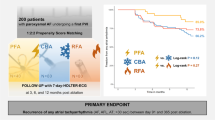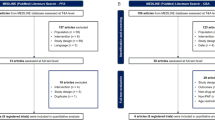Abstract
Purpose
Pulmonary vein isolation (PVI) by cryoballoon ablation (CBA) has emerged as a commonly used technique for the treatment of atrial fibrillation. We sought to explore the incidence, risk factors for, and characterization of post-CBA-PVI atrial flutter.
Methods
We analyzed a prospective registry of patients who underwent CBA-PVI at a single institution. We included patients with more than 3 months of follow-up data and excluded those with a history of cavotricuspid isthmus (CTI) ablation. Locations of post-CBA-PVI atrial flutters were determined by analysis of intracardiac electrograms and electroanatomic maps.
Results
There were 556 patients included in the analysis. The mean age was 61.0 ± 10.6 years, 67.4% were male, the number of failed anti-arrhythmic medication trials was 1.2 ± 0.8, and the duration of atrial fibrillation pre-CBA was 54.3 ± 69.1 months. The 28-mm second-generation cryoballoon was used almost exclusively. Over a median follow-up time of 22.7 ± 17.9 months, 25 (4.5%) patients developed post-CBA-PVI atrial flutter after the 3-month blanking period. Of those 25 patients, 15 (60%) underwent subsequent ablation to eliminate the atrial flutter circuit, with 60% being CTI-dependent and the remainder left-sided (p value not significant). Risk factors for the development of atrial flutter included NYHA class ≥ 2 (OR 5.02, p < 0.001), presence of baseline bundle branch block (OR 4.33, p = 0.006), and left ventricular ejection fraction < 50% (OR 3.36, p = 0.007).
Conclusions
The rate of post-CBA-PVI atrial flutter is low after the blanking period even with medium-term follow-up. The origin of atrial flutter is equally divided between the right and left atria.


Similar content being viewed by others
References
Haissaguerre M, Jais P, Shah DC, Takahashi A, Hocini M, Quiniou G, et al. Spontaneous initiation of atrial fibrillation by ectopic beats originating in the pulmonary veins. N Engl J Med. 1998;339(10):659–66.
Kuck KH, Brugada J, Furnkranz A, Metzner A, Ouyang F, Chun KR, et al. Cryoballoon or radiofrequency ablation for paroxysmal atrial fibrillation. N Engl J Med. 2016;374(23):2235–45.
Akerstrom F, Bastani H, Insulander P, Schwieler J, Arias MA, Jensen-Urstad M. Comparison of regular atrial tachycardia incidence after circumferential radiofrequency versus cryoballoon pulmonary vein isolation in real-life practice. J Cardiovasc Electrophysiol. 2014;25(9):948–52.
Wasserlauf J, Pelchovitz DJ, Rhyner J, Verma N, Bohn M, Li Z, et al. Cryoballoon versus radiofrequency catheter ablation for paroxysmal atrial fibrillation. Pacing Clin Electrophysiol : PACE. 2015;38(4):483–9.
Straube F, Dorwarth U, Ammar-Busch S, Peter T, Noelker G, Massa T, et al. First-line catheter ablation of paroxysmal atrial fibrillation: outcome of radiofrequency vs. cryoballoon pulmonary vein isolation. Europace. 2016;18(3):368–75.
Lee G, Sanders P, Kalman JM. Catheter ablation of atrial arrhythmias: state of the art. Lancet (London, England). 2012;380(9852):1509–19.
Coutino HE, de Asmundis C, Mugnai G, Moran D, De Regibus V, Stroker E, et al. Repeat procedures after second-generation cryoballoon ablation as an index procedure for persistent atrial fibrillation: one-year follow-up. J Interv Card Electrophysiol. 2016;47(3):365–71.
East C, Phan T, Filardo G, Franklin J, Donsky A, Wheelan KR, et al. Repeat ablation and hospitalization following cryoballoon ablation of atrial fibrillation at a single tertiary medical center. Proceedings. 2017;30(1):3–6.
Mikhaylov EN, Bhagwandien R, Janse PA, Theuns DA, Szili-Torok T. Regular atrial tachycardias developing after cryoballoon pulmonary vein isolation: incidence, characteristics, and predictors. Europace. 2013;15(12):1710–7.
Cardoso R, Mendirichaga R, Fernandes G, Healy C, Lambrakos LK, Viles-Gonzalez JF, et al. Cryoballoon versus radiofrequency catheter ablation in atrial fibrillation: a meta-analysis. J Cardiovasc Electrophysiol. 2016;27(10):1151–9.
Hermida A, Kubala M, Traulle S, Buiciuc O, Quenum S, Hermida JS. Prevalence and predictive factors of left atrial tachycardia occurring after second-generation cryoballoon ablation of atrial fibrillation. J Cardiovasc Electrophysiol. 2018;29(1):46–54.
Calkins H, Hindricks G, Cappato R, Kim YH, Saad EB, Aguinaga L, et al. 2017 HRS/EHRA/ECAS/APHRS/SOLAECE expert consensus statement on catheter and surgical ablation of atrial fibrillation. Heart Rhythm. 2017;14(10):e275–444.
Deo R, Berger R. The clinical utility of entrainment pacing. J Cardiovasc Electrophysiol. 2009;20(4):466–70.
Pedrinazzi C, Durin O, Mascioli G, Curnis A, Raddino R, Inama G, et al. Atrial flutter: from ECG to electroanatomical 3D mapping. Heart Int. 2006;2(3–4):161.
Cosio FG. Atrial flutter, typical and atypical: a review. Arrhythmia Electrophysiol Rev. 2017;6(2):55–62.
Medi C, Kalman JM. Prediction of the atrial flutter circuit location from the surface electrocardiogram. Europace. 2008;10(7):786–96.
Gerstenfeld EP, Dixit S, Bala R, Callans DJ, Lin D, Sauer W, et al. Surface electrocardiogram characteristics of atrial tachycardias occurring after pulmonary vein isolation. Heart Rhythm. 2007;4(9):1136–43.
Steinberg JS, Romanov A, Musat D, Preminger M, Bayramova S, Artyomenko S, et al. Prophylactic pulmonary vein isolation during isthmus ablation for atrial flutter: the PReVENT AF Study I. Heart Rhythm. 2014;11(9):1567–72.
Mesquita J, Ferreira AM, Cavaco D, Carmo P, Madeira M, Freitas P, et al. Impact of prophylactic cavotricuspid isthmus ablation in atrial fibrillation recurrence after a first pulmonary vein isolation procedure. Int J Cardiol. 2018;259:82–7.
Nery PB, Belliveau D, Nair GM, Bernick J, Redpath CJ, Szczotka A, et al. Relationship between pulmonary vein reconnection and atrial fibrillation recurrence: A Systematic Review and Meta-Analysis. JACC Clin Electrophysiol. 2016;2(4):474–83.
Rahman F, Wang N, Yin X, Ellinor PT, Lubitz SA, LeLorier PA, et al. Atrial flutter: clinical risk factors and adverse outcomes in the Framingham Heart Study. Heart Rhythm. 2016;13(1):233–40.
Da Costa A, Mourot S, Romeyer-Bouchard C, Thevenin J, Samuel B, Kihel A, et al. Anatomic and electrophysiological differences between chronic and paroxysmal forms of common atrial flutter and comparison with controls. Pacing Clin Electrophysiol: PACE. 2004;27(9):1202–11.
Medi C, Teh AW, Roberts-Thomson K, Morton JB, Kistler PM, Kalman JM. Right atrial remodeling is more advanced in patients with atrial flutter than with atrial fibrillation. J Cardiovasc Electrophysiol. 2012;23(10):1067–72.
Nattel S, Shiroshita-Takeshita A, Cardin S, Pelletier P. Mechanisms of atrial remodeling and clinical relevance. Curr Opin Cardiol. 2005;20(1):21–5.
Talman V, Ruskoaho H. Cardiac fibrosis in myocardial infarction-from repair and remodeling to regeneration. Cell Tissue Res. 2016;365(3):563–81.
Manolis AS. Contemporary diagnosis and management of atrial flutter: a continuum of atrial fibrillation and vice versa? Cardiol Rev. 2017;25(6):289–97.
Author information
Authors and Affiliations
Contributions
JRBConcept/design, data analysis/interpretation, drafting article.
RKConcept/design, critical revision of article.
CLD, GP, AABData collection, critical revision of article.
AT, JW, ABC, RA, SK, AL, NVData acquisition, approval of article.
BPKConcept/design, critical revision of article.
RSPConcept/design, data analysis/interpretation, drafting article, critical revision of article.
Corresponding author
Ethics declarations
The institutional review board at Northwestern University approved the study protocol.
Conflict of interest
Bradley P. Knight receives honoraria for consulting and speaking for Medtronic Inc. Rod S. Passman receives research support, consulting fees, and speaker fees from Medtronic; royalties from UpToDate; and research support from Pfizer and Kardia. Northwestern University receives fellowship support from Medtronic, Inc.
Additional information
Publisher’s note
Springer Nature remains neutral with regard to jurisdictional claims in published maps and institutional affiliations.
Rights and permissions
About this article
Cite this article
Baman, J.R., Kaplan, R.M., Diaz, C.L. et al. Characterization of atrial flutter after pulmonary vein isolation by cryoballoon ablation. J Interv Card Electrophysiol 57, 233–240 (2020). https://doi.org/10.1007/s10840-019-00560-9
Received:
Accepted:
Published:
Issue Date:
DOI: https://doi.org/10.1007/s10840-019-00560-9




